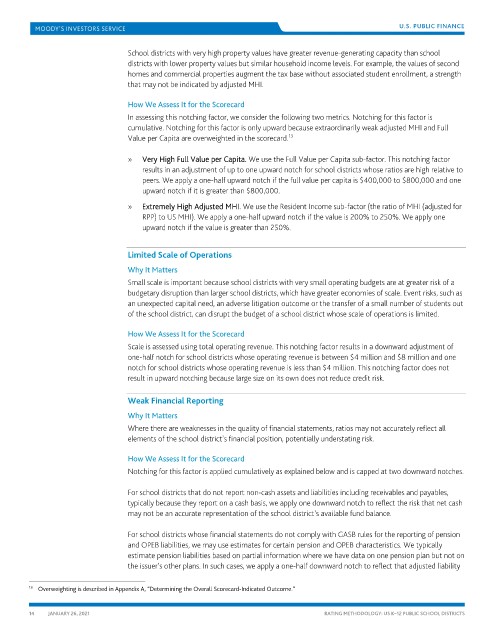Page 1648 - draft
P. 1648
U.S. PUBLIC FINANCE
School districts with very high property values have greater revenue-generating capacity than school
districts with lower property values but similar household income levels. For example, the values of second
homes and commercial properties augment the tax base without associated student enrollment, a strength
that may not be indicated by adjusted MHI.
How We Assess It for the Scorecard
In assessing this notching factor, we consider the following two metrics. Notching for this factor is
cumulative. Notching for this factor is only upward because extraordinarily weak adjusted MHI and Full
13
Value per Capita are overweighted in the scorecard.
» Very High Full Value per Capita. We use the Full Value per Capita sub-factor. This notching factor
results in an adjustment of up to one upward notch for school districts whose ratios are high relative to
peers. We apply a one-half upward notch if the full value per capita is $400,000 to $800,000 and one
upward notch if it is greater than $800,000.
» Extremely High Adjusted MHI. We use the Resident Income sub-factor (the ratio of MHI (adjusted for
RPP) to US MHI). We apply a one-half upward notch if the value is 200% to 250%. We apply one
upward notch if the value is greater than 250%.
Limited Scale of Operations
Why It Matters
Small scale is important because school districts with very small operating budgets are at greater risk of a
budgetary disruption than larger school districts, which have greater economies of scale. Event risks, such as
an unexpected capital need, an adverse litigation outcome or the transfer of a small number of students out
of the school district, can disrupt the budget of a school district whose scale of operations is limited.
How We Assess It for the Scorecard
Scale is assessed using total operating revenue. This notching factor results in a downward adjustment of
one-half notch for school districts whose operating revenue is between $4 million and $8 million and one
notch for school districts whose operating revenue is less than $4 million. This notching factor does not
result in upward notching because large size on its own does not reduce credit risk.
Weak Financial Reporting
Why It Matters
Where there are weaknesses in the quality of financial statements, ratios may not accurately reflect all
elements of the school district’s financial position, potentially understating risk.
How We Assess It for the Scorecard
Notching for this factor is applied cumulatively as explained below and is capped at two downward notches.
For school districts that do not report non-cash assets and liabilities including receivables and payables,
typically because they report on a cash basis, we apply one downward notch to reflect the risk that net cash
may not be an accurate representation of the school district’s available fund balance.
For school districts whose financial statements do not comply with GASB rules for the reporting of pension
and OPEB liabilities, we may use estimates for certain pension and OPEB characteristics. We typically
estimate pension liabilities based on partial information where we have data on one pension plan but not on
the issuer’s other plans. In such cases, we apply a one-half downward notch to reflect that adjusted liability
13 Overweighting is described in Appendix A, “Determining the Overall Scorecard-Indicated Outcome.”
14 JANUARY 26, 2021 RATING METHODOLOGY: US K–12 PUBLIC SCHOOL DISTRICTS

